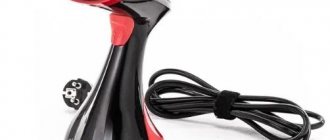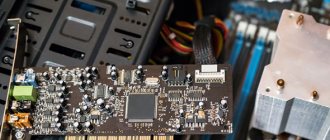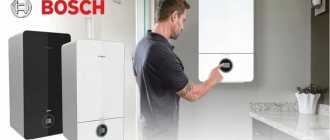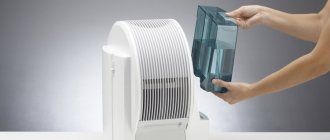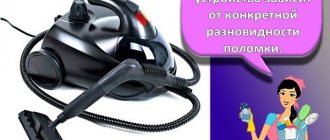Design and principle of operation
Despite the external similarity of the working elements, the operating principle of these devices is radically different.
The main components of the iron:
- Metal platform with a heating element hidden in it.
- A power cord that is attached to a terminal block.
- Water chamber hidden inside the body.
- Thermostat, which is responsible for regulating the temperature.
- Steam generation system, which includes a steam boost button and a supply intensity regulator.
When you turn on the device, the soleplate heats up to the desired temperature. Water poured into the chamber, when you press the “steam boost” button, enters the tank in portions, where it is instantly heated, coming into contact with a hidden heating element, and comes out in the form of steam through the holes in the sole.
Key components of steam stations:
- Iron.
- Steam line.
- Housing with boiler and control panel.
- Power cable.
Water is poured into the tank, when the device is turned on, it heats up to a high temperature (about 130 ° C), turns into dry steam and is supplied through a hose to the iron. Depending on the model, the control panel may contain feed regulators, a pressure gauge, and work readiness indicators. From the moment the device is turned on, it takes 2–10 minutes to fully warm up.
The steamer is similar in design to a steam generator. Water is poured into the boiler in the same way and supplied through a hose. The main differences between these devices:
- Steam has a lower temperature (about 90o C).
- Do not iron with the working attachment.
- Ready for use within 30 seconds after switching on.
- Steam comes out naturally or under slight pressure.
The main purpose of the steamer is to remove odors and wrinkles from vertically hanging items.
Advantages and disadvantages of the iron
The irons are compact, easy to take on the road, and when folded, such devices take up minimal space. If we talk about the minuses, then these are:
- solving only simple problems;
- impossibility of delicate ironing (low temperature modes are ineffective and not always safe).
Models with a steam generator are more expensive and larger. You can buy them if your budget allows, you want to understand how the steam function works. A generator is a much more efficient option.
Important! The efficiency of the steamer largely depends on the volume of the tank.
Iron - an inexpensive universal option for all occasions
Model functionality
Most of the functions of the iron and the device with a steam generator are identical. Only a few parameters may differ.
Vertical steaming
This function is included in almost all models costing over 500 rubles. However, it is implemented differently. To steam vertically hanging items with a regular iron, you need to hold it suspended (the weight of the model with water can be 1.5-2 kg) and periodically press the steam button. In this case, after each release of steam, the device needs to gain temperature, therefore, there will be constant pauses in operation.
In models with a steam generator, steam is supplied continuously, in a much larger volume; moreover, the weight of the iron is much less (from 0.8 kg), therefore, it is easier to hold it in weight.
splashing
This feature is found in almost all classic models. This does not always happen in devices with a steam generator. For those who are used to refreshing laundry the “old-fashioned” way, the lack of a nozzle can cause some inconvenience.
What to choose?
Each housewife has her own views on everyday life. Some prefer to use time-tested, reliable irons. Others keep track of innovative technologies and try something new all the time. Still others don’t see any point in ironing bedding and some clothes. Therefore, it is impossible to say unequivocally that a steamer, or a steam generator, or an iron is better. You need to choose the technology for yourself.
Please note:
- the number and nature of items requiring ironing;
- budget;
- ease of use.
If you need a device for clothes made of simple fabrics and little ironing, you can limit yourself to the classics. If there is a large volume of work and there are delicate items, you should make a choice between a steam generator and a sender.
Before purchasing, you need to carefully weigh all the advantages and disadvantages of different equipment and specific models, or even better, test the devices personally. For example, visiting a friend.
To summarize, we emphasize that a steam generator, a steamer, and a modern iron do an excellent job and make clothes look attractive with a minimum of effort. Of course, the steam function significantly speeds up the smoothing process, but such devices are more expensive and break down more often. Therefore, when thinking about what to choose, you should start from your needs and financial capabilities.
Descaling
If in ordinary irons, during a burst of steam, particles of lime are thrown onto the fabric, then in steam generators this situation is practically excluded - the water is heated at the base, and comes out in the form of steam.
Therefore, in classic models it is necessary to clean the internal tank; in steam stations, maintenance is required for the boiler. The cleaning method depends not so much on the type of device, but on the model and specific company.
Other functions, such as auto shutdown, energy saving mode, sound or light indication of readiness for use, can be found in devices of different types.
The steamer does not have a variety of programs, only the steam supply is regulated, but it can have a rich set, which includes clips for trousers, a brush attachment for clothes, hangers on which to hang a shirt, etc.
Iron with steam generator
A wide selection of irons allows you to choose a device to suit every taste:
- with a narrow sole and holes on the nose - for clothes with a lot of details;
- with a wide sole, rounded at the back - for bedding, tablecloths and the like;
- miniature - for travel;
- with constant steam supply - for quickly smoothing delicate fabric;
- with a boost of steam - to remove unruly folds from linen or cotton.
In irons, the water is heated by a heating element located in the sole. To make it boil, you need to turn on the device at maximum power, and when steam comes out, set the heat regulator to the type of fabric you are going to iron.
In addition to steaming, many models have a sprinkler on the spout to soften the most unruly folds on things with droplets of water. The wire connecting the iron to the network is sometimes removed, which allows the iron to work autonomously for some time at any distance from the outlet. This is especially true when you need to steam hanging curtains.
But some inconveniences are still present in electric irons, otherwise steam generators would not have been created.
- The high initial temperature of the sole often causes things made from synthetic fabrics to burn.
- Manufacturers do not always equip irons with a cord of sufficient length for comfortable ironing.
- The volume of the water tank is 200-300 ml, maximum 400 ml.
- The time you can use steam is limited by the volume of the tank: you don’t always have time to iron all your clothes.
- The steam pressure on the fabric leaves much to be desired: the iron does not always cope with overdried shirts made from natural materials. You have to make an effort to straighten the fabric.
- Filled with water, the device weighs a lot.
- Your hand gets tired because you first need to lift the heavy iron and then press harder on the fabric.
Despite the shortcomings, the main advantage of the electric iron is its price. This makes him an indispensable assistant in the household.
Weight, mobility and size
The weight of the iron in steam stations is significantly less than classic models, since they do not have a water tank. However, the total mass of a steam station is on average 5–7 kg.
In addition, the boiler takes up a lot of storage space. When ironing, the steam station requires a special area for installation - a stand on a regular wooden board is not suitable for its placement.
To make it easier to carry, many manufacturers equip the device with a lock that securely secures the iron to the base. This way you can carry the entire structure by the handle.
The steamer is similar in size to a steam generator. The device is often equipped with a vertical stand on which clothes or a hose with a nozzle are hung.
Pros and cons of a steam generator
Advantages:
- The iron in a steam generator is lighter than a regular one with steam due to the fact that the water tank is located separately.
- Smoothes the roughest fabrics.
- Vertical or horizontal ironing - your choice.
- By filling the reservoir with water once, you can iron a large amount of laundry.
Flaws:
- It’s an expensive pleasure, but many housewives believe that it’s better to spend money and buy a steam generator for a home with a large family than a regular iron.
- Large due to the water tank, it is difficult to carry and store.
- Noisy, as steam under pressure makes a sound similar to hissing.
- You have to additionally purchase replacement cartridges for the tank and distilled water.
Speed and quality of ironing
In many ways, the speed of ironing depends on the ease of sliding of the sole over the fabric. The following materials are used in the manufacture of the platform:
- Aluminum.
- Teflon.
- Stainless steel.
- Ceramics.
- Metal ceramics.
Aluminum material is soft, it scratches easily and does not have non-stick properties. Fabric particles will not stick to Teflon coating, however, such a surface can be easily scratched by metal accessories on clothing. Stainless steel conducts heat well and is durable, but does not have non-stick properties.
These materials are rarely found in their pure form, only in budget models. As a rule, manufacturers try to modify them or combine them with other materials to impart strength and non-stick properties.
Ceramics and cermets are much more common. They have good non-stick properties and glide perfectly over the fabric. Such coatings are found in steam stations and in classic irons, so the ironing speed of these devices is approximately the same and depends more on the specific model and manufacturer.
In addition, the speed of ironing depends on the intensity of steaming - the faster the device straightens the folds, the sooner the item will acquire a neat appearance. In this case, the model with a steam generator, which is capable of smoothing fabric folded in 3-4 layers in one pass, will definitely win. An iron or steamer for home clothes will not cope with this task.
You can iron shirts using a steam generator or steamer directly on the hanger. In this case, the steamer does not come into direct contact with the fabric; it cannot straighten out folds due to the high temperature of the surface of the nozzle. The feeding intensity is also low, so in order to smooth out wrinkles and wrinkles you have to go through the same area several times.
What to focus on when making a choice
Here are a few criteria by which any housewife can safely decide which assistant is better for ironing.
- Wardrobe. Decide what items dominate the closet hangers. Silk, chiffon, thin fabrics will “make friends” with the steamer. It will be indispensable in a large family, where everyone has more than one warm clothes. It is difficult to iron and remove creases on a coat, raincoat or jacket after seasonal storage. But it will be enough for the rest of the wardrobe, especially if there are outfits made of natural and woolen fabrics on the hangers.
- Functionality. The steamer does more than just remove wrinkles. It helps rid clothes of unpleasant odors; disinfect things that are difficult to wash: large bedspreads, pillows, mattresses.
- Place in the apartment. Although the ironing board takes up a lot of space, there is a corner for it and the iron in most apartments. But sometimes difficulties arise with storing a large and tall device. But you can look for models with a telescopic leg and with folding hangers, with a smaller volume of the water tank.
- Ironing speed. The iron is maneuverable. The presence of a steam boost allows them to work in both horizontal and vertical planes (you can remove a small crease in a curtain or blouse hanging on a hanger). In addition, it is not advisable to take out the steamer to quickly iron an item before leaving the house - it will take time to heat the water.
It seems that the steam generator benefits from its versatility. But it is inferior to the iron in other parameters. Buy equipment based only on your personal needs, without succumbing to advertising slogans. Then a real irreplaceable assistant will appear in your home, and not a useless device on which an impressive part of the family budget has been spent.
Subscribe to our Social networks
Difficulty to use
It is difficult to steam curtains or vertically hanging clothes with a regular iron, since the entire weight of the device rests on your outstretched arm.
It is difficult to tidy up heavily wrinkled clothes with a steamer, since this device does not have an ironing function. But the device can be placed on the floor and rolled to the desired location, even if it is in another room. In the case of a steam generator, performing such an operation is quite problematic. You will have to assemble the device and drag it manually, and then still look for a place to install it.
Which device is best for home use?
To make the right choice between an iron and a steamer, you need to understand how often you need to iron your clothes:
- For those who dress in office style every day or iron their children's school uniforms, a steamer will come in handy. But it is necessary to take into account that the creases on the trousers will have to be ironed.
- If there is no need to regularly iron your wardrobe items , there is no point in spending money on purchasing state-of-the-art equipment. You can limit yourself to buying an iron with a water tank - it can handle wrinkles on shirts or dresses quite well.
- Families who often go on business trips can purchase a small travel iron for travel and a steamer for home use.
For your information! Don't forget about the financial side of the issue. A good iron can steam things better than a cheap steam generator with low power.
How to make a choice
When thinking about what to choose for your home: an iron, a steamer or an iron with a steam generator, you need to determine in advance what tasks the device should perform.
If the owner plans to constantly iron on a board and process curtains a couple of times a year, it is worth choosing a classic model with a good steam boost.
If the buyer most often has to tidy up outerwear, suits and other delicate items, but does not want to overpay for sophisticated equipment, a steamer would be the best option.
If you have to iron often and a lot, and the buyer is not tasked with saving money, the optimal solution would be a steam generator that can replace both a regular iron and a steamer.
When choosing a steam generator, iron or steamer, you should carefully study the technical characteristics of the device and the rating of the best models in order to choose the best option for your needs.
Steamer
The main difference between a steamer and a simple iron with a steam generator is its dimensions. He is massive and seems clumsy. When you look at it, the question arises: where should I put you to stroke it? You can’t take such a unit on the road, and it’s not particularly convenient to wear with curtains. In general, doubts arise at first glance whether it is worth replacing the iron with a steamer. And when you look at its cost, the same goes for the second one.
Let's explore this miracle of technology in more detail. Let's carefully consider its functions and features.
Storage tank
A large boiler that holds up to 2.5 liters of liquid (10 times more than an electric iron!) means you don’t have to worry about running out of water soon. In addition, steam is supplied under pressure, which allows you to iron even fabric folded in several layers or thick: this significantly saves ironing time and your effort. Electricity, by the way, too.
The cord from the outlet goes to the boiler, and from it comes a combined steam hose and a new cable. The total distance from the outlet reaches 3 meters, allowing you to choose a convenient place for ironing.
Iron
The weight of the iron in the steam generator is small, as is its size: all the liquid is heated separately. The hand does not have time to get tired for several reasons:
- low weight of the iron;
- powerful emanating steam;
- no need to press on the surface of the clothing.
The design of the iron is simple: a sole with a heating element and a thermostat. There is no difference between the soles of different types of devices. They are made of steel, ceramic, titanium or aluminum with protective layers for improved glide.
The initial temperature on the steam generator iron is set immediately in accordance with the type of material that will be ironed. This protects the fabric from the danger of being burned. The indicator light turning off will indicate that the steam generated is sufficient to begin the process.


